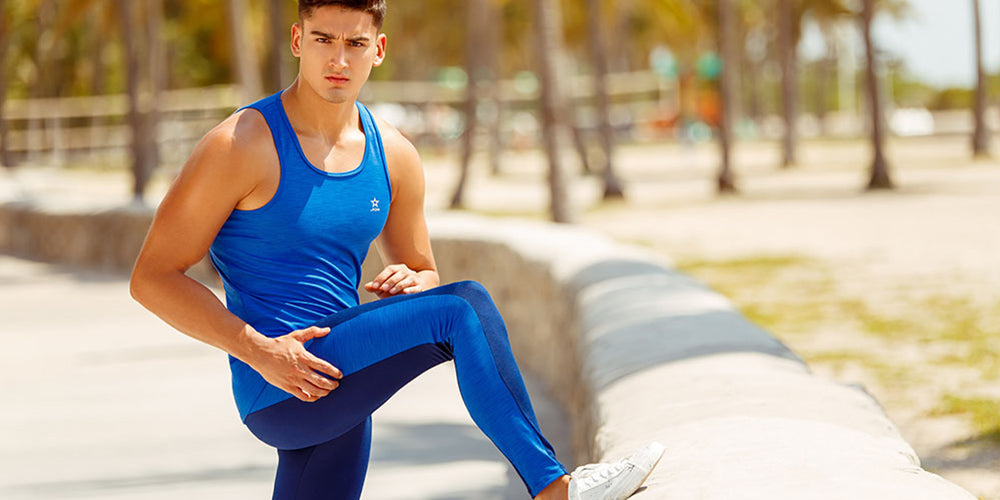Let's be honest. What you wear to the gym, on the trail, or during a run isn't just about looking good (though that’s a great bonus). It’s about performance, comfort, and confidence. The right fitness apparel can be the difference between a personal best and a workout cut short by chafing, overheating, or restricted movement.
For Australian men, the challenge is even more specific. Our unique climate from the humid coasts to the dry, scorching interiors demands clothing that can handle sweat, sun, and sudden changes in weather. You need gear that is as resilient and dynamic as you are.
This ultimate guide will walk you through everything you need to know to find the best men's fitness apparel in Australia, backed by insights on fabric technology and performance. We'll cover the key features to look for, the different types of clothing for various activities, and why investing in quality is a game-changer for your fitness journey.
Why Your Workout Gear Matters More than You Think
It's easy to grab any old t-shirt and shorts, but performance apparel is engineered for a purpose. Here’s why it’s a crucial part of your routine:
- Moisture Management: Cotton might be comfortable for lounging, but it's the enemy of a serious workout. It absorbs sweat and holds it against your skin, leaving you feeling wet, heavy, and cold once you stop moving. Technical fabrics are designed to wick moisture away from your skin to the outer surface of the fabric, where it can evaporate quickly. This keeps you dry and regulates your body temperature.
- Freedom of Movement: Whether you’re hitting a deep squat, reaching for a yoga pose, or sprinting, your clothing should move with you, not against you. Look for designs with four way stretch and ergonomic seams that allow for a full range of motion without bunching or binding.
- Durability & Longevity: Quality fitness apparel is an investment. It’s made to withstand repeated washing, intense stretching, and exposure to sweat without losing its shape, colour, or functionality. Cheap alternatives often pill, fade, or tear after just a few months.
- Comfort & Chafe Prevention: Nothing ruins a long run or workout like chafing. Flatlock seams, tagless labels, and soft, seamless constructions are designed to minimise friction against your skin, preventing irritation and letting you focus on your performance.
- Confidence Boost: When you look good, you feel good. Wearing apparel that fits well, looks sharp, and performs flawlessly gives you a psychological edge. It helps you get in the zone and approach your workout with greater focus and determination.

Key Features to Look for in Australian Fitness Apparel
Given our environment, here are the non-negotiable features to prioritise:
- Breathability & Ventilation: Look for mesh panels, lightweight fabrics, and engineered knit patterns that promote airflow. This is essential for staying cool during high intensity interval training (HIIT) or outdoor cardio in the Australian heat.
- Sweat Wicking Fabric: As mentioned, this is paramount. Fabrics like Polyester, Nylon, and Elastane blends are the gold standard. They are hydrophobic, meaning they repel water and push sweat to the fabric's surface. Research in the Textile Research Journal highlights that the hydrophobicity of polyester fibres is a key driver for superior moisture management in sportswear.
- UV Protection: For any outdoor activity running, hiking, sports UPF (Ultraviolet Protection Factor) rated clothing is a huge advantage. It acts as a physical barrier against the sun's harmful rays, protecting your skin during long exposures. Cancer Council Australia recommends wearing sun protective clothing as a primary defence against UV radiation.
- Odour Resistance: Many premium brands treat their fabrics with anti microbial technology that prevents the growth of odour causing bacteria. This means your gear stays fresher for longer, both during and between washes. Studies have shown that silver based and other antimicrobial finishes can significantly reduce bacterial growth on textiles.
- The Perfect Fit: Fit is everything. Your apparel shouldn’t be so loose that it gets in the way, nor so tight that it restricts circulation. Look for terms like "compression," "fitted," and "standard" to find the right balance for your activity and preference.
Breaking Down the Wardrobe: Essential Gear for Every Activity
Your workout dictates your wardrobe. Here’s a breakdown of the essential pieces and what to look for in each.
1. Performance Tops & T-Shirts
The foundation of any gym outfit.
- Material: Avoid 100% cotton. Opt for a polyester/spandex blend for the best blend of wicking and stretch.
- Fit: Choose a fitted but not restrictive cut. Raglan sleeves often offer better mobility for upper body workouts.
- Style: From sleek, minimalist singlets to stylish graphic tees, choose a style that matches your personality and the intensity of your workout.
2. Training Shorts
perhaps the most versatile piece of fitness apparel.
- Length: Ranges from above-the-knee "split" shorts for runners to longer 7-9" shorts for gym training. Choose what you're most comfortable with.
- Liner vs. Linerless: Lined shorts have a built in compression layer, eliminating the need for separate underwear. Linerless shorts offer more flexibility to wear your preferred underwear or compression tights.
- Pockets: A secure zip pocket for keys, cards, or a phone is a must have for most people.
3. Compression Wear
More than just a trend, compression gear serves a real purpose.
- Benefits: Improves blood circulation, reduces muscle fatigue and vibration, and can speed up recovery. It also provides a protective layer against chafing. A meta analysis published in Sports Medicine concluded that compression garments are effective in enhancing recovery from muscle damaging exercise.
- When to Wear: Ideal under shorts for leg day, during long distance runs, or as recovery wear after an intense session.
4. Baselayers & Hoodies
For early morning or late evening workouts, especially in cooler Australian regions.
- Function: A good baselayer should be lightweight, warm, and still wick moisture. A fitness hoodie should be made from a technical fleece that breathes, unlike a heavy cotton hoodie that will trap sweat.
5. Socks & Underwear
The unsung heroes of workout comfort.
- Socks: Look for merino wool or synthetic blends that cushion key areas, wick moisture, and have arch support to prevent blisters.
- Underwear: Seamless, moisture-wicking, and breathable. Never wear cotton underwear for a workout.

MYOVV: Engineered for the Australian Man
At MYOVV, we understand the demands of the Australian active lifestyle. We don’t just sell fitness apparel; we engineer it. Our collections are designed with the specific needs of Australian men in mind, blending cutting edge fabric technology with thoughtful, performance-driven design.
Here’s what sets MYOVV apart:
- Climate-Adaptive Fabrics: Our proprietary blends are ultra-breathable and exceptionally quick-drying, making them perfect for a gruelling session in a humid Sydney gym or a scorching run in Perth.
- Uncompromising Fit: We’ve spent countless hours perfecting our patterns. Our clothing offers a sculpted, athletic fit that complements your physique while providing unrestricted movement for everything from powerlifting to Pilates.
- Durability You Can Trust: We use high grade, durable fabrics and reinforced stitching to ensure your MYOVV gear stands the test of time, rep after rep, wash after wash.
- Style Meets Performance: We believe you shouldn’t have to sacrifice style for function. Our designs are modern, sleek, and versatile you’ll look as good heading to a café as you do crushing your workout.
From our premium training shorts with secure pockets to our moisture-wicking tees that feel like a second skin, every piece is a testament to our commitment to quality. We are dedicated to providing Australian men with the best fitness apparel that empowers them to perform at their peak.
Caring for Your Investment: Make Your Gear Last Longer
Quality apparel deserves quality care. Follow these simple tips to extend the life of your fitness wear:
- Wash in Cold Water: Hot water can break down elastic fibres (spandex) and damage moisture-wicking properties.
- Avoid Fabric Softeners: They coat the fibres, clogging the fabric's ability to wick moisture and breathe.
- Turn Garments Inside Out: This protects the outer surface from friction and pilling in the wash.
- Air Dry Whenever Possible: Tumble dryers generate high heat that can degrade fabrics and shrink clothing. Hang-drying is the gentlest option.
- Wash Promptly: Don’t let sweaty gear sit in a gym bag for days. This can set in stains and allow odour-causing bacteria to multiply.
Frequently Asked Questions (FAQs)
Q1: What is the best fabric for men's gym wear?
The best fabrics are synthetic blends, primarily Polyester and Nylon, with a small percentage of Elastane (also known as Spandex or Lycra). Polyester is excellent for moisture wicking and durability, while Nylon adds softness and strength. Elastane provides the essential stretch for freedom of movement.
Q2: Why shouldn't I wear cotton for working out?
Cotton is a "hydrophilic" fabric, meaning it absorbs water (sweat) and holds it against your skin. This makes you feel heavy, wet, and cold, and significantly increases the risk of chafing and irritation. It also dries very slowly, which can lead to discomfort and even hypothermia in cool conditions, as noted by outdoor safety experts [5].
Q3: How should men's fitness shorts fit?
They should sit comfortably on your waist without being too tight. The leg openings should allow for full range of motion (like high knees and deep squats) without riding up excessively. The length is a personal preference, but it shouldn't hinder your movement.
Q4: What is the difference between compression and fitted clothing?
Compression wear is very tight and designed to apply graduated pressure to muscles to improve blood flow and support. Fitted wear is snug to the body, follows your contours without applying significant pressure, and is primarily for comfort and a streamlined look.
Q5: Is expensive fitness apparel worth it?
While the upfront cost is higher, premium fitness apparel is absolutely worth the investment. You are paying for advanced fabric technology, superior construction, better durability, and designs that genuinely enhance your performance and comfort. It lasts significantly longer than fast fashion alternatives, making it more cost effective in the long run.
Q6: How many sets of workout clothes do I need?
This depends on how often you train. A good starting point is 3-4 sets: enough to get you through your weekly workouts without having to do laundry constantly. This typically includes tops, bottoms, and socks.
Q7: Can I wear my fitness apparel for casual everyday wear?
Absolutely! The lines between activewear and casualwear have blurred. A well designed, stylish performance t-shirt or a pair of sleek training shorts can easily be integrated into your everyday wardrobe for a comfortable, athletic look.
Research References
-
Majumdar, A., Das, A., & Alagirusamy, R. (2010). Studies on Moisture Management of Polyester Knitted Fabrics. Textile Research Journal. This study analyses the moisture management properties of polyester, a primary fabric in sportswear.
URL: https://journals.sagepub.com/doi/10.1177/0040517510387206 -
Cancer Council Australia. (n.d.). Sun Protection. This resource outlines the importance of sun-protective clothing as part of a comprehensive sun safety strategy.
URL: https://www.cancer.org.au/cancer-information/causes-and-prevention/sun-safety -
Gao, Y., & Cranston, R. (2008). Recent Advances in Antimicrobial Treatments of Textiles. Textile Research Journal. This review paper discusses various antimicrobial agents used in textiles to control odour-causing bacteria.
URL: https://journals.sagepub.com/doi/10.1177/0040517507081342 -
Hill, J., Howatson, G., van Someren, K., Leeder, J., & Pedlar, C. (2013). Compression Garments and Recovery from Exercise-Induced Muscle Damage: A Meta-Analysis. Sports Medicine. This meta-analysis evaluates the scientific evidence on compression garments for muscle recovery.
URL: https://link.springer.com/article/10.1007/s40279-013-0066-5 -
National Health Service (NHS) UK. (2021). Hypothermia. The NHS advises that wearing wet clothing in windy or cold conditions is a major risk factor for hypothermia, highlighting the danger of cotton during physical activity in the cold.
URL: https://www.nhs.uk/conditions/hypothermia/



Leave a comment
This site is protected by hCaptcha and the hCaptcha Privacy Policy and Terms of Service apply.